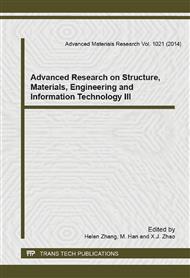p.218
p.225
p.229
p.233
p.240
p.247
p.251
p.257
p.261
Study of Iron-Carbon Micro-Electrolysis Degrading Dyeing Effluent by Appending Transition Metals and Rare Earths
Abstract:
The paper aims to explore influence of elements of transition metal (TM) and rare earth (RE) on iron-carbon micro-electrolysis for dyeing effluent degradation. There is evidence that there aren't many reports about it in domestic literature. The paper analysed the morphologies of surfaces of irons and activated carbons and designed the orthogonal experiments. Next was discussion for related influence factors. It deduced the mechanism that TMs and REs assist zero-valent iron (Fe0) catalysing degradation of dyeing effluent. It is based on following explanation. Cations of manganese and cobalt easily penetrate Fe0 lattices, but doesn't Ce4+ because of larger radius. Thus Ce4+ is weaker than Mn2+ and Co2+ for improving Fe0 activity. Furthermore, because the valence electron structure of Mn2+ is more stable than that of Co2+, Mn2+ is more efficient to assist Fe0 degrading dyeing effluent than Co2+. Therefore, the ranking of affecting Fe0 activity from greatest to smallest is Mn2+, Co2+ and Ce4+.
Info:
Periodical:
Pages:
240-244
Citation:
Online since:
August 2014
Authors:
Price:
Сopyright:
© 2014 Trans Tech Publications Ltd. All Rights Reserved
Share:
Citation:


